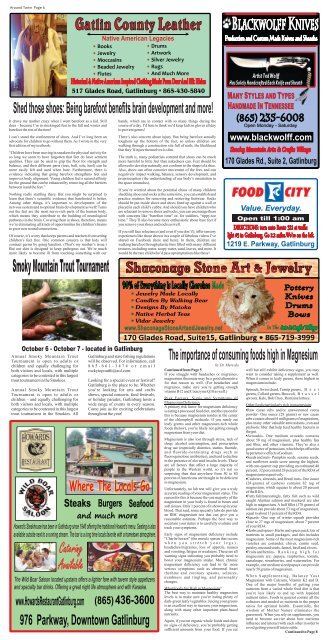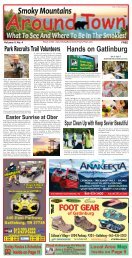Smoky Mountain Around Town / September 2018
What To See And Where To Be In The Smokies!
What To See And Where To Be In The Smokies!
Create successful ePaper yourself
Turn your PDF publications into a flip-book with our unique Google optimized e-Paper software.
<strong>Around</strong> <strong>Town</strong> Page 6<br />
Native American Legacies<br />
• Books<br />
• Jewelry<br />
• Moccasins<br />
• Beaded Jewelry<br />
• Flutes<br />
• Drums<br />
• Artwork<br />
• Silver Jewelry<br />
• Rugs<br />
• And Much More<br />
Shed those shoes: Being barefoot benefits brain development and more!<br />
It drove my mother crazy when I went barefoot as a kid. Still<br />
does – because I’m in stockinged feet in the fall and winter and<br />
barefoot the rest of the time!<br />
I can’t stand the confinement of shoes. And I’ve long been an<br />
advocate for children to go without them. As I wrote in the very<br />
first edition of my textbook:<br />
“Children have been moving in sneakers for physical activity for<br />
so long we seem to have forgotten that feet do have sentient<br />
qualities. They can be used to grip the floor for strength and<br />
balance, and their different parts (toes, ball, sole, heel) can be<br />
more easily felt and used when bare. Furthermore, there is<br />
evidence indicating that going barefoot strengthens feet and<br />
improves body alignment. Young children feel a natural affinity<br />
for the ground that can be enhanced by removing all the barriers<br />
between it and the feet.”<br />
Nothing really startling there. But you might be surprised to<br />
learn that there’s scientific evidence that barefooted is better.<br />
Among other things, it’s important to development of the<br />
nervous system and to optimal brain development as well! Turns<br />
out the feet are the most nerve-rich parts of the human body,<br />
which means they contribute to the building of neurological<br />
pathways in the brain. Covering them in shoes, therefore, means<br />
we’re eliminating all kinds of opportunities for children’s brains<br />
to grow new neural connections.<br />
Of course, it’s worry that keeps parents and teachers from setting<br />
children’s feet free. One common concern is that kids will<br />
contract germs by going barefoot. (That’s my mother’s issue.)<br />
But our skin is designed to keep pathogens out. We’re much<br />
more likely to become ill from touching something with our<br />
hands, which are in contact with so many things during the<br />
course of a day. I’d hate to think we’d keep kids in gloves all day<br />
to prevent germs!<br />
There’s also concern about injury. But being barefoot actually<br />
toughens up the bottom of the feet, so unless children are<br />
walking through a construction site full of nails, the likelihood<br />
that they’ll injure themselves is slim.<br />
The truth is, many podiatrists contend that shoes can be much<br />
more harmful to little feet than nakedness can. Feet should be<br />
allowed to develop naturally, not conform to the shape of a shoe.<br />
Also, shoes can often constrict movement of the feet, and can<br />
negatively impact walking, balance, sensory development, and<br />
proprioception (the understanding of our body’s orientation in<br />
the space around us).<br />
If you’re worried about the potential chaos of many children<br />
shedding shoes and socks at the same time, you can establish and<br />
practice routines for removing and retrieving footwear. Socks<br />
should be put inside shoes and shoes lined up against a wall or<br />
placed in each child’s cubby. And should you have children who<br />
are reluctant to remove shoes and socks, you can encourage them<br />
with concepts like “barefoot time” or, for toddlers, “tippy-toe<br />
time.” They’ll also become more enthusiastic about bare feet if<br />
you remove your shoes and socks as well.<br />
If you still face reluctance (and even if you don’t!), offer sensory<br />
experiences like those shown in a couple of fabulous videos I’ve<br />
shared on Facebook (here and here). In them, children are<br />
walking barefoot through plastic bins filled with many different<br />
textures, including water, soapy water, sand, leaves, and more. It<br />
would be the rare child who’d pass up temptations like these!<br />
A r st T ed Wolff<br />
H as S olely H andcra ed E ach K nife and S heath<br />
MANY STYLES AND TYPES<br />
HANDMADE IN TENNESSEE<br />
Open Monday - Saturday<br />
www.blackwolff.com<br />
170 Glades Rd., Suite 2, Gatlinburg<br />
Value. Everyday.<br />
Open till 1:00 am<br />
1219 E. Parkway, Gatlinburg<br />
<strong>Smoky</strong> <strong>Mountain</strong> Trout Tournament<br />
American Sideshow Antiques - 373 Parkway, Gatlinburg - 865-325-1411<br />
www.ShaconageStoneArtandJewelry.net<br />
October 6 - October 7 - located in Gatlinburg<br />
Annual <strong>Smoky</strong> <strong>Mountain</strong> Trout<br />
Tournament is open to adults or<br />
children and equally challenging for<br />
both visitors and locals, with multiple<br />
categories to be contested in this largest<br />
trout tournament in the Smokies.<br />
Annual <strong>Smoky</strong> <strong>Mountain</strong> Trout<br />
Tournament is open to adults or<br />
children – and equally challenging for<br />
both visitors and locals, with multiple<br />
categories to be contested in this largest<br />
trout tournament in the Smokies. All<br />
Steaks<br />
Howard's Steakhouse has been in Gatlinburg since 1946 offering the traditional Howard’s menu. Seating is also<br />
available outside next to a running stream. The bar is a long time locals favorite with a hometown atmosphere.<br />
Catering<br />
Available<br />
The Wild Boar Saloon located upstairs offers a lighter fare with tavern style appetizers<br />
and specialty bar drinks. Offering a great night life atmosphere and with Karaoke.<br />
www.HowardsRestaurantGatlinburg.com<br />
Gatlinburg and state fishing regulations<br />
will be observed. For information, call<br />
8 6 5 - 6 6 1 - 3 4 7 4 o r e m a i l<br />
rockytopoutfit@aol.com.<br />
Looking for a special event or festival?<br />
Gatlinburg is the place to be. Whether<br />
you’re looking for arts and crafts<br />
shows, special concerts, food festivals,<br />
or holiday parades, Gatlinburg hosts a<br />
wide range of events in every season.<br />
Come join us for exciting celebrations<br />
throughout the year!<br />
Where The Locals Go<br />
Burgers<br />
and much more<br />
Seafood<br />
(865) 436-3600<br />
976 Parkway, Downtown Gatlinburg<br />
The importance of consuming foods high in Magnesium<br />
by Dr. Mercola<br />
Continued from Page 5<br />
If you struggle with headaches or migraines,<br />
magnesium threonate may be a good alternative<br />
for that reason as well. (For headaches and<br />
migraines, make sure you’re getting enough<br />
vitamin B12 and Coenzyme Q10 as well.)<br />
Risk Factors, Signs and Symptoms of<br />
Magnesium Deficiency<br />
A primary risk factor for magnesium deficiency<br />
is eating a processed food diet, and the reason for<br />
this is because magnesium resides at the center<br />
of the chlorophyll molecule. If you rarely eat<br />
leafy greens and other magnesium-rich whole<br />
foods (below), you’re likely not getting enough<br />
magnesium from your diet.<br />
Magnesium is also lost through stress, lack of<br />
sleep, alcohol consumption, and prescription<br />
drug use (especially diuretics, statins, fluoride,<br />
and fluoride-containing drugs such as<br />
fluoroquinolone antibiotics), and tend to decline<br />
in the presence of elevated insulin levels. These<br />
are all factors that affect a large majority of<br />
people in the Western world, so it’s not so<br />
surprising then that anywhere from 50 to 80<br />
percent of Americans are thought to be deficient<br />
in magnesium.<br />
Unfortunately, no lab test will give you a truly<br />
accurate reading of your magnesium status. The<br />
reason for this is because the vast majority of the<br />
magnesium in your body is found in bones and<br />
soft tissues. Only 1 percent of it shows up in your<br />
blood. That said, some specialty labs do provide<br />
an RBC magnesium test that can give you a<br />
reasonable estimate. Perhaps the best way to<br />
ascertain your status is to carefully evaluate and<br />
track your symptoms.<br />
Early signs of magnesium deficiency include<br />
“Charlie horses” (the muscle spasm that occurs<br />
w h e n y o u s t r e t c h y o u r l e g s ) ,<br />
headaches/migraines, loss of appetite, nausea<br />
and vomiting, fatigue or weakness. These are all<br />
warning signs indicating you probably need to<br />
boost your magnesium intake. More chronic<br />
magnesium deficiency can lead to far more<br />
serious symptoms such as abnormal heart<br />
rhythms and coronary spasms, seizures,<br />
numbness and tingling, and personality<br />
changes.<br />
What Foods Are High in Magnesium?<br />
The best way to maintain healthy magnesium<br />
levels is to make sure you’re eating plenty of<br />
dark-green leafy vegetables. Juicing your greens<br />
is an excellent way to increase your magnesium,<br />
along with many other important plant-based<br />
nutrients.<br />
Again, if you eat organic whole foods and show<br />
no signs of deficiency, you’re probably getting<br />
sufficient amounts from your food. If you eat<br />
well but still exhibit deficiency signs, you may<br />
want to consider taking a supplement as well.<br />
When it comes to leafy greens, those highest in<br />
magnesium include:<br />
Spinach , Swiss chard , Turnip greens , B e e t<br />
greens , Collard greens, Broccoli , B r u s s e l<br />
sprouts , Kale , Bok Choy , Romaine lettuce.<br />
Other foods particularly rich in magnesium:<br />
•Raw cacao nibs and/or unsweetened cocoa<br />
powder - One ounce (28 grams) or raw cacao<br />
nibs contain about 64 milligrams of magnesium,<br />
plus many other valuable antioxidants, iron and<br />
prebiotic fiber that help feed healthy bacteria in<br />
the gut.<br />
•Avocados - One medium avocado contains<br />
about 58 mg of magnesium, plus healthy fats<br />
and fiber, and other vitamins. They’re also a<br />
good source of potassium, which helps offset the<br />
hypertensive effects of sodium.<br />
•Seeds and nuts - Pumpkin seeds, sesame seeds,<br />
and sunflower seeds score among the highest,<br />
with one-quarter cup providing an estimated 48<br />
percent, 32 percent and 28 percent of the RDA of<br />
magnesium respectively.<br />
•Cashews, almonds, and Brazil nuts- One ounce<br />
(28-grams) of cashews contains 82 mg of<br />
magnesium, which equates to about 20 percent<br />
of the RDA.<br />
•Fatty fish Interestingly, fatty fish such as wild<br />
caught Alaskan salmon and mackerel are also<br />
high in magnesium. A half fillet (178 grams) of<br />
salmon can provide about 53 mg of magnesium,<br />
equal to about 13 percent of the RDA.<br />
•Squash - One cup of winter squash provides<br />
close to 27 mgs of magnesium; about 7 percent<br />
of your RDA.<br />
•Herbs and spices - Herbs and spices pack lots of<br />
nutrients in small packages, and this includes<br />
magnesium. Some of the most magnesium-rich<br />
varieties are coriander, chives, cumin seed,<br />
parsley, mustard seeds, fennel, basil and cloves.<br />
•Fruits and berries - R a n k i n g h i g h f o r<br />
magnesium are: papaya, raspberries, tomato,<br />
cantaloupe, strawberries, and watermelon. For<br />
example, one medium sized papaya can provide<br />
nearly 58 grams of magnesium.<br />
W h e n S u p p l e m e n t i n g , B a l a n c e Yo u r<br />
Magnesium with Calcium, Vitamin K2 and D.<br />
One of the major benefits of getting your<br />
nutrients from a varied whole food diet is that<br />
you’re less likely to end up with lopsided<br />
nutrient ratios. Foods in general contain all the<br />
cofactors and needed co-nutrients in the proper<br />
ratios for optimal health. Essentially, the<br />
wisdom of Mother Nature eliminates the<br />
guesswork. When you rely on supplements, you<br />
need to become savvier about how nutrients<br />
influence and interact with each other in order to<br />
avoid getting yourself into trouble.<br />
Continued to Page 8















